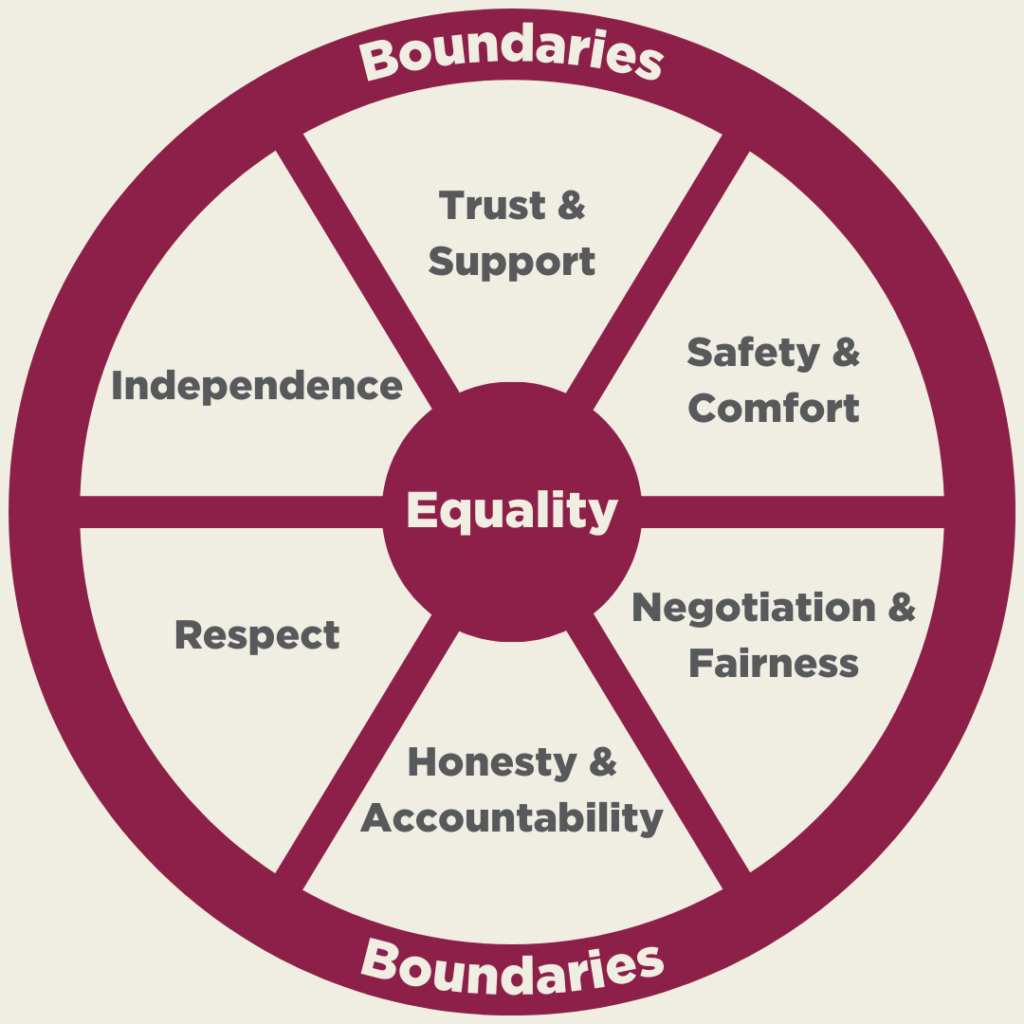What is a relationship?
A relationship (noun) is “a connection formed between two or more people or groups based on social interactions and mutual goals, interests, or feelings” (Oxford English Dictionary). Throughout our lives, we will form many relationships with other people. Some relationships may be transactional and temporary, whereas others may be close and permanent. It is important that we prioritize having healthy relationships with the people we are close to, including friends, roommates, family, classmates, and yes, romantic partners. By practicing healthy relationships in all aspects of our lives, we can normalize healthy behavior and recognize red flags more quickly. It’s important to note that the signs of power and control can pop up in any relationship.
Check out our printable Healthy Relationships Coloring Book.
Do you know the signs of a healthy relationship?
Healthy relationships are based on Equality. The Equality Wheel helps us understand the important components of a healthy relationship. Equality should be at the center of all healthy relationships. It means having the same status, rights, opportunities, and value as one another in the relationship. It’s about making decisions together, having the same amount of voice, and ensuring everyone in the relationship has an open seat at the decision-making table.
- You can believe, rely on, and be good to one another.
- You support one another’s passions and goals.
- Emotionally affirming and understanding one another.
- Knowing that you aren’t manipulating, misleading, or taking advantage of one another.
- Ensuring you can express yourselves.
- Creating an environment where everyone feels safe.
- Knowing that you won’t intentionally hurt one another.
- The relationship feels like “home.”
- Seeking mutually-satisfying resolutions to conflict.
- Accept changes.
- Being able to “agree to disagree.”
- Being willing and able to compromise.
- Prioritizing fair, equitable distribution of responsibilities.
- Accepting responsibility for yourselves and your actions.
- Admitting when you are wrong, apologizing, and seeking to make amends.
- Communicating openly and truthfully.
- Holding each other accountable.
- Appreciating one another’s viewpoints, opinions, beliefs, and decisions.
- Setting, observing, and respecting each other’s boundaries.
- Recognizing the importance of the relationship, treating it with care.
- Giving each other room to breathe.
- Prioritizing yourself. Taking time alone or with others you care about.
- Not expecting each other to fulfill all of your needs, complete you, or solve all problems.
Boundaries surround the equality wheel. They are necessary for healthy relationships, and they can change as we change. Healthy boundaries are the limits and rules we set for ourselves within and outside relationships. We are able to say “no” to things when we want to, but are also comfortable opening up to things we do want to experience. Think about healthy boundaries as a fence with a gate. The fence keeps what you want in your yard in and what you don’t want out. You can open the gate if you would like to let something in, or you can close it to keep something out. You get to decide what you open that gate up to.
What are some signs of an abusive relationship?
The Power and Control Wheel can help us understand the signs of abusive relationships. Power and Control are at the root of relationship abuse. Abuse is all about having power and control over another person. Each of the spokes of the Power and Control Wheel are abusive strategies used to exert power and control over a partner. Any ONE of these can point to an abusive relationship
- Putting you or making you feel bad about yourself.
- Playing mind games.
- Making you feel guilty.
- Name-calling.
- Controlling what you do or read.
- Controlling who you see or talk to.
- Controlling where you go.
- Limiting your involvement with others or keeping you from seeing family or friends.
- Using jealousy to justify their actions.
- Controlling your access to money and/or classes.
- Preventing you from getting or keeping a job or going to class.
- Taking your money.
- Threatening to embarrass or leave you.
- Pressuring you to commit illegal actions or engage in behaviors you don’t want to.
- Threatening to hurt themselves or end their own life.
- Making or carrying out threats to hurt you.
- AKA “Gaslighting.”
- Making light of abuse.
- Saying the abuse didn’t happen.
- Saying you caused the abuse.
- Shifting responsibility of abusive behavior.
- Making you feel afraid by using looks, actions, or gestures.
- Displaying weapons.
- Destroying things or property when angry.
- Abusing your pets or children.
Violence is often used as the mechanism to exert power and control over another person. Relationship violence is prohibited under the UT Policy on Sexual Harassment, Sexual Assault, Dating and Domestic Violence, and Stalking. There are resources and supports available for students who have experienced or are experiencing relationship violence.
Campus Resources
Community Resources
- Helen Ross McNabb – Domestic Violence
- Knoxville Family Justice Center
- YWCA Knoxville
- Community Coalition Against Human Trafficking
Online & National Resources
- Love Is Respect
- National Domestic Violence Hotline
- Rape, Abuse, & Incest National Network (RAINN)
- Stalking Prevention, Awareness, & Resource Center (SPARC)
The Equality and Power and Control Wheels are adapted from the Domestic Abuse Intervention Project, Duluth, Minnesota.

